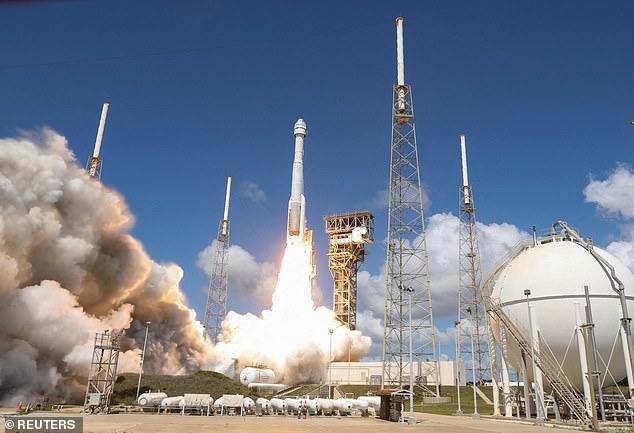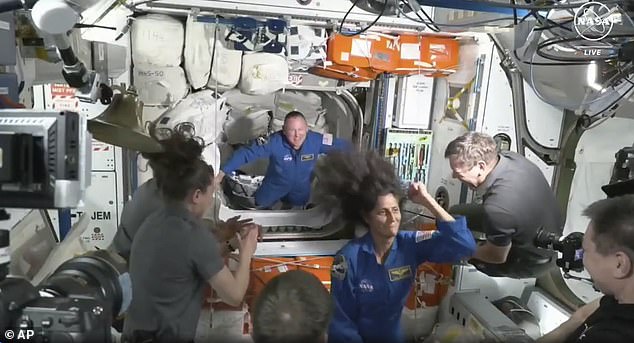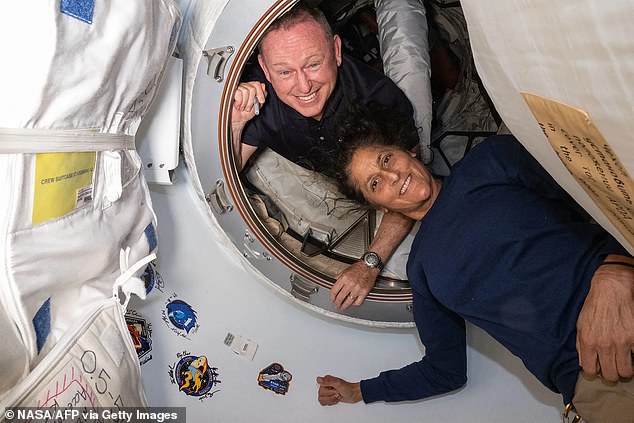Camping in sleeping bags. Going days without washing. Facing life-altering health risks.
Stranded NASA astronauts Sunita Williams and Barry Wilmore are “having a tough time” on the International Space Station as they remain stranded there with no official return date.
Boeing’s faulty Starliner has extended what was supposed to be an eight-day mission into a possible eight-month duration of great stress and uncertainty.
Reports suggest astronauts are living in less than ideal conditions, including a lack of adequate sleeping facilities, increasing psychological stress and escalating health risks.
But despite all this, NASA officials boldly claimed that astronauts loved it during a news conference on Wednesday.
NASA officials insist astronauts Barry Wilmore (left) and Sunita Williams (right) are “doing fine” while stranded on the International Space Station, despite reports of difficult conditions.
“I know if I was in his position I would be very happy to be there,” said Kenneth Bowersox, associate administrator for NASA’s Space Operations Mission Directorate.
“I would love to have extra time.”
Each additional day they spend there puts greater strain on their bodies, as microgravity and space radiation deteriorate their health.
Williams and Wilmore were only supposed to be aboard the ISS for eight days when they launched on Boeing’s Starliner in June, but a problem with the craft’s propulsion system means it’s not safe to undock them and bring them home.
NASA and Boeing have been working on a plan to return astronauts safely to Earth, but will not have a decision until the end of the month, officials said at a briefing Wednesday.
Officials are currently weighing the risks of sending Williams and Wilmore home on the faulty Starliner versus SpaceX’s Crew Dragon spacecraft, which is scheduled to launch in September.
Going the SpaceX route would mean astronauts would remain on the ISS until February 2025, extending their mission to eight months.
An unexpectedly long stay within the cramped conditions of the ISS is sure to test astronauts’ patience, especially when it comes to sleeping arrangements.

Boeing’s faulty Starliner blasted off to the International Space Station with Williams and Wilmore aboard in June. NASA and Boeing are still deciding whether the spacecraft is safe enough to bring them home.
The ISS is only equipped with six private sleep chambers, but there were already seven astronauts on board when Williams and Wilmore arrived, Time reported.
This means that three of them are left without suitable accommodation to sleep in.
Williams and one of the astronauts already on the station sleep in less sophisticated sleep chambers called Crew Sleep Accommodations Alternative (CASA).
But Wilmore is forced to camp out in a sleeping bag inside the Japanese Space Agency’s Kibo module.
“Butch is going to have to endure some hardship,” Williams told Time editor Jeffrey Kluger, who spoke to the astronauts in May when they thought they would only endure these conditions for about a week.
Williams also expressed some discomfort with the lack of showers on the ISS during an interview with the Society of Women Engineers on August 8.
“Of course, we don’t have showers here,” he said. “Maybe I would have prepared a little better for that.”
She added that on the ISS she can only wash her hair about twice a week.
Minor annoyances like these can weigh heavily on astronauts spending long periods of time on board the ISS, and can even lead to psychological problems.
In simulated space missions, some experience the “third trimester phenomenon”: a drop in motivation occurs when astronauts realize that the time they have left in their situation is as long as they have already lived.

Overcrowded conditions, lack of adequate sleeping facilities and psychological stress may be testing the patience of stranded astronauts.
This can make them feel irritable, tense and unmotivated.
Despite all these challenges, NASA officials say Williams and Wilmore are having a great time up there — for now.
They’re enjoying the surroundings, “eating that delicious space food” and being able to look out the window, Bowersox said during the briefing.
“I know they’re making the best of this moment, but I’m sure they’re anxious to make a decision like the rest of us,” he added.
But even though astronauts put on a good face, their bodies suffer from the harsh conditions of space flight.
Many studies have shown that prolonged stays in space can cause loss of bone density, muscle atrophy, intense radiation exposure, vision problems, and other major health problems.
Eight months would not be the longest time an astronaut has spent on the ISS.
But with each passing day, Williams and Wilmore are at greater risk of developing cancer, osteoporosis and diseases that can result from long-duration spaceflight.
At this point, NASA and Boeing are no closer to bringing astronauts home, but are working to identify the safest return strategy.


